1lumen selects and reviews products personally. We may earn affiliate commissions through our links, which help support our testing.
Klarus XT2CR Pro review
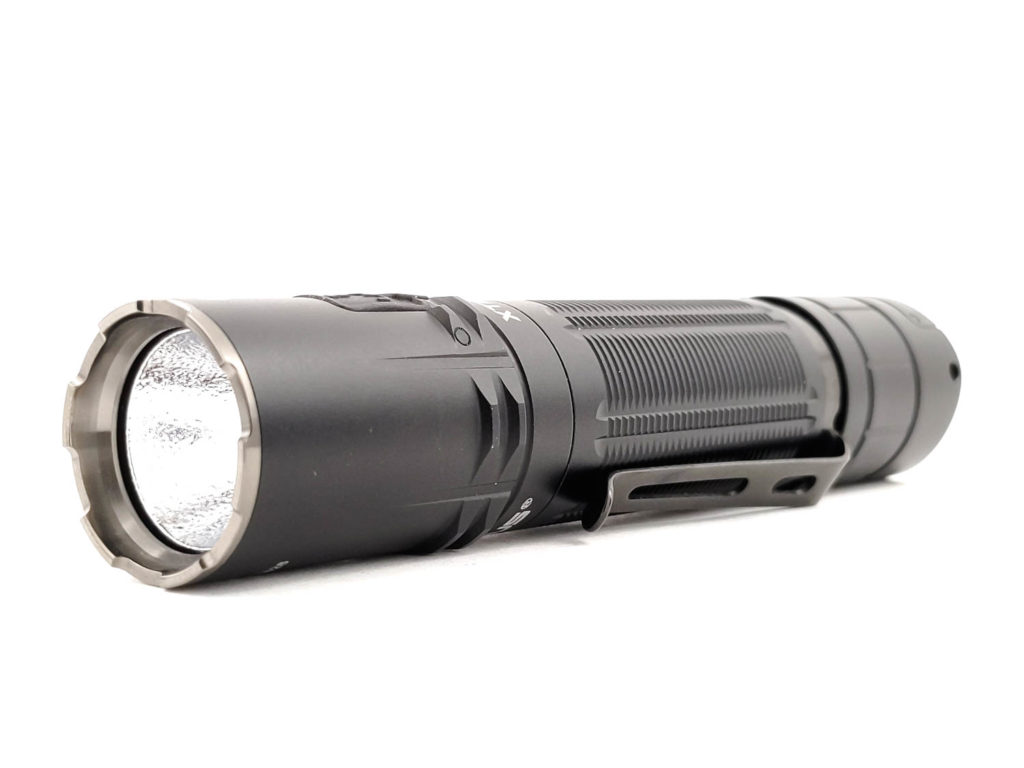
Klarus XT2CR Pro specifications
| Brand/model | Klarus XT2CR Pro |
|---|---|
| LED | CREE XHP35 HD |
| Lumens | 2,100 lm |
| Beam intensity | 14,400 cd |
| Battery config. | 1*18650 / 2*CR123A |
| Material | Aluminum |
| Modes | 4 |
| Blinkies | Strobe, SOS |
| Reflector | OP (orange peel) |
| Waterproof | IPX8 |
| Review date | November 2021 |
Introduction:
Klarus has been making tactical-oriented flashlights for over ten years now and this is one of the latest additions to their “XT” (Extreme Tactical) series. I thought XT2CR Pro looked like a cool new take on an EDC tactical light, with its dual-tail-switches and USB-C charging. I hoped it would be a great competitor for Olight’s Warrior Mini 2 which is dominating the EDC tactical light market right now, without needing a proprietary battery or charging cable. Read on for details!
Package quality.
The box is a high-quality, white, retail box with lots of information about the light printed on it. The lid lifts off like a board game box, and inside is more nice printing with important info like how to remove the insulator on the battery. The light comes inside a holster, and all other accessories come in their own little box inside the main box. The following items are included in the box:
- Klarus XT2CR Pro flashlight
- 3100mah protected 18650 battery
- Spare o-ring
- Lanyard
- Manual
- USB A-to-C charging cable
- Belt holster
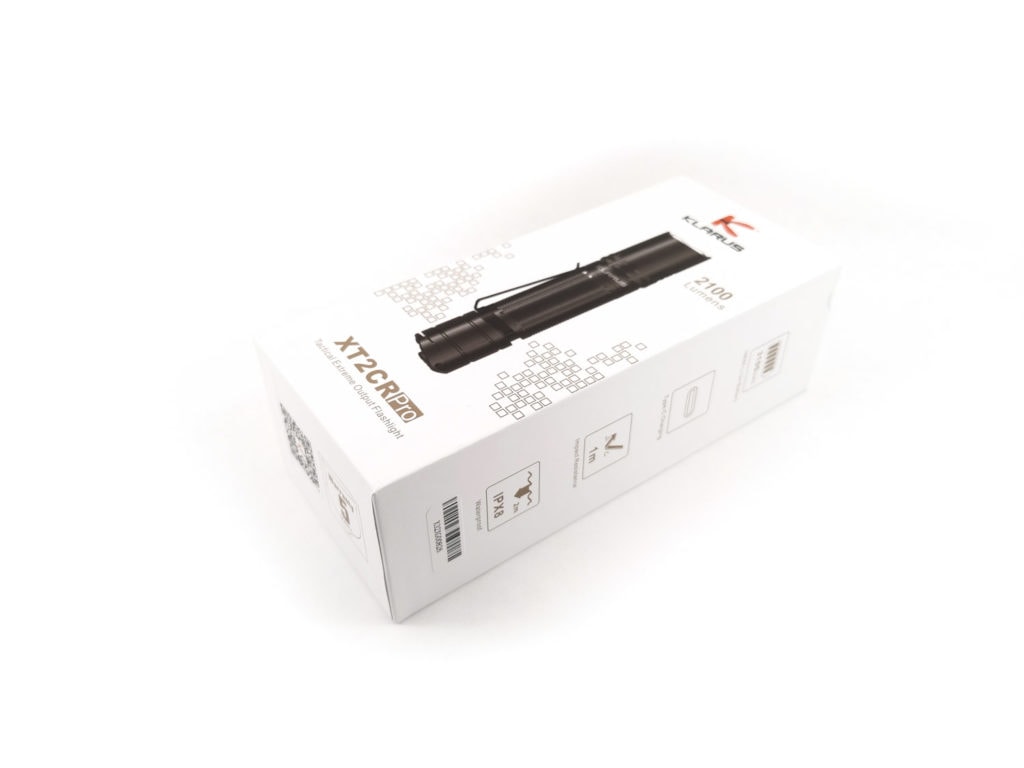
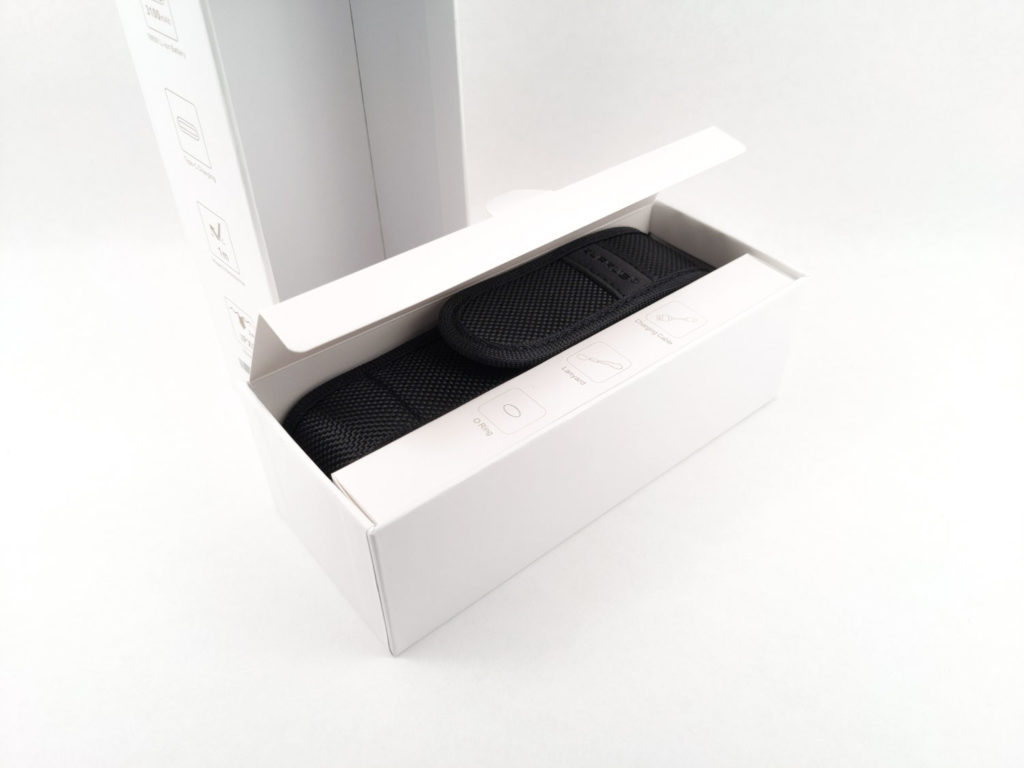
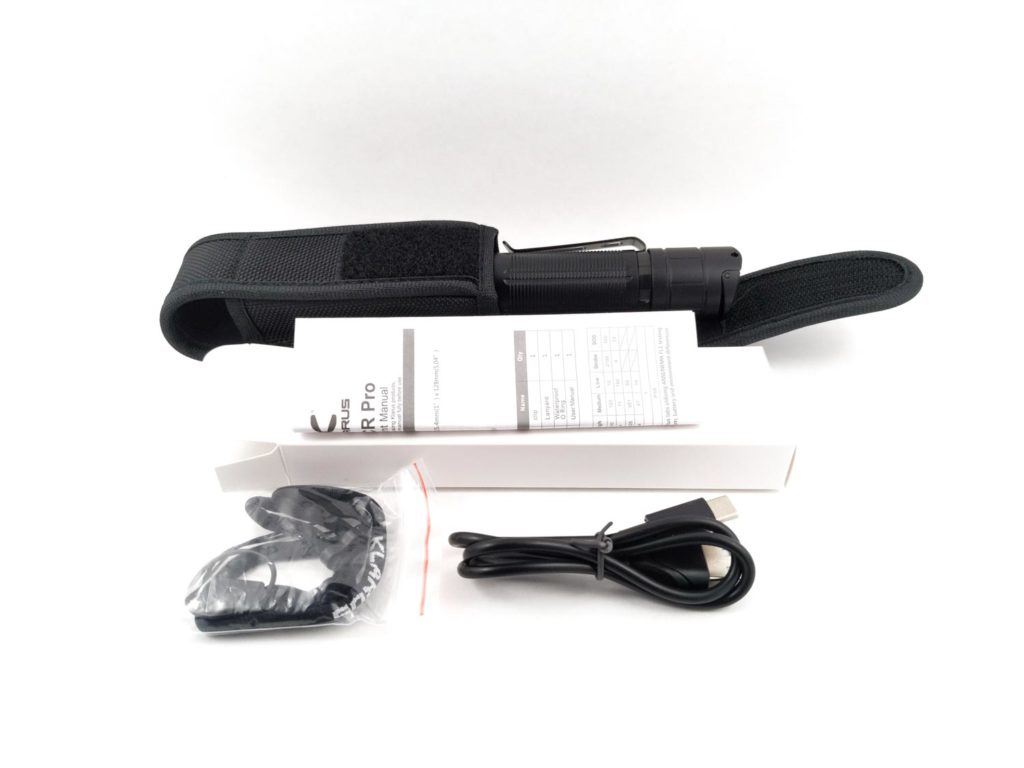
Flashlight in use
Ergonomically XT2CR Pro is fine. There aren’t any hotspots and it fits in the hand well. But, I find it can be a little awkward to press the main switch without also pressing the paddle switch.
The Klarus XT2CR Pro uses a unique dual tailswitch design. The main switch is a forward clicky mechanical covered by a rubber boot. It requires a fair amount of force to actuate so it shouldn’t be pressed by accident. This switch provides instant access to turbo mode. There’s also an electronic paddle switch next to the main switch. It provides access to low or strobe from off and changing modes while on. I find that in a normal grip, I often accidentally press both switches when I only mean to press the rubber one, because it requires so much force to actuate.
Klarus includes several carry methods. The main one is a pocket clip, which is fairly shallow and extremely strong. It feels like it’ll tear a pants pocket to shreds in a week. I tried bending out the clip to make it less aggressive but it’s extremely springy and just bounced back every time. It’s worth noting that the tailcap actually captures the clip slightly when it’s tightened down all the way, so there’s no way this clip will pop off by accident.
Klarus also includes a nice belt holster. The closure is velcro and the light fits snugly. On the back of the holster, there’s a velcro strap for attaching to/removing from a belt without having to remove the belt. For more security, there’s also a sewed down loop that requires you to remove the belt for attachment. A good quality lanyard is included as well, with two different attachment points on the tailcap.
Tailstanding isn’t possible, but there are some milled protrusions on the head to prevent rolling.
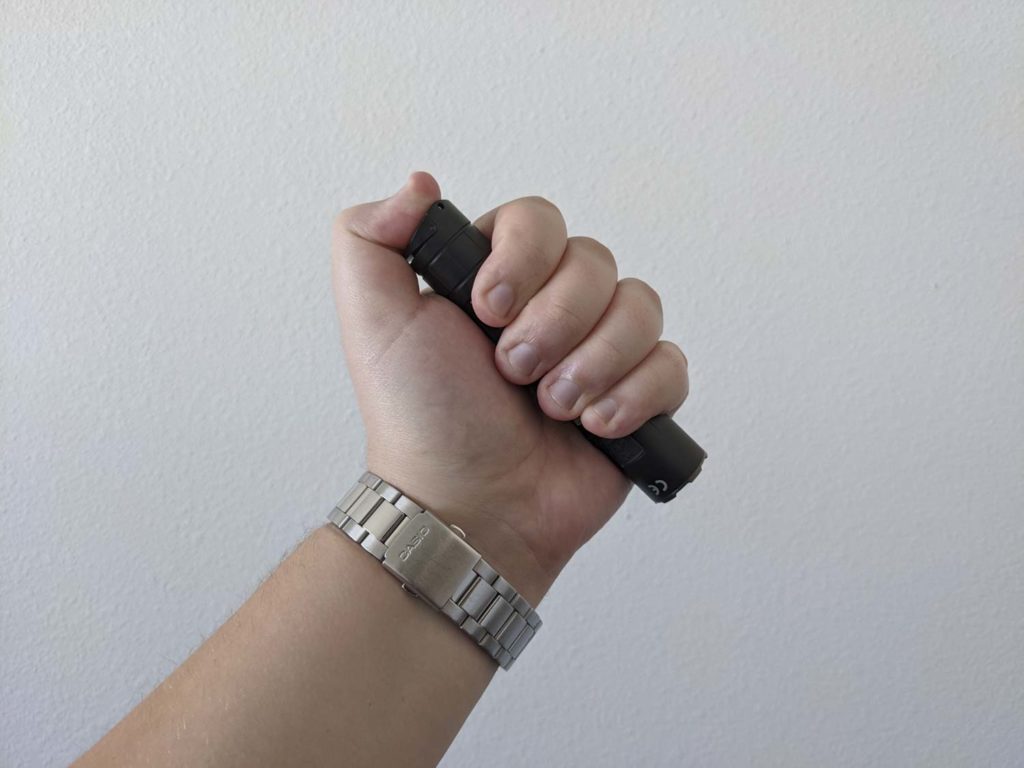
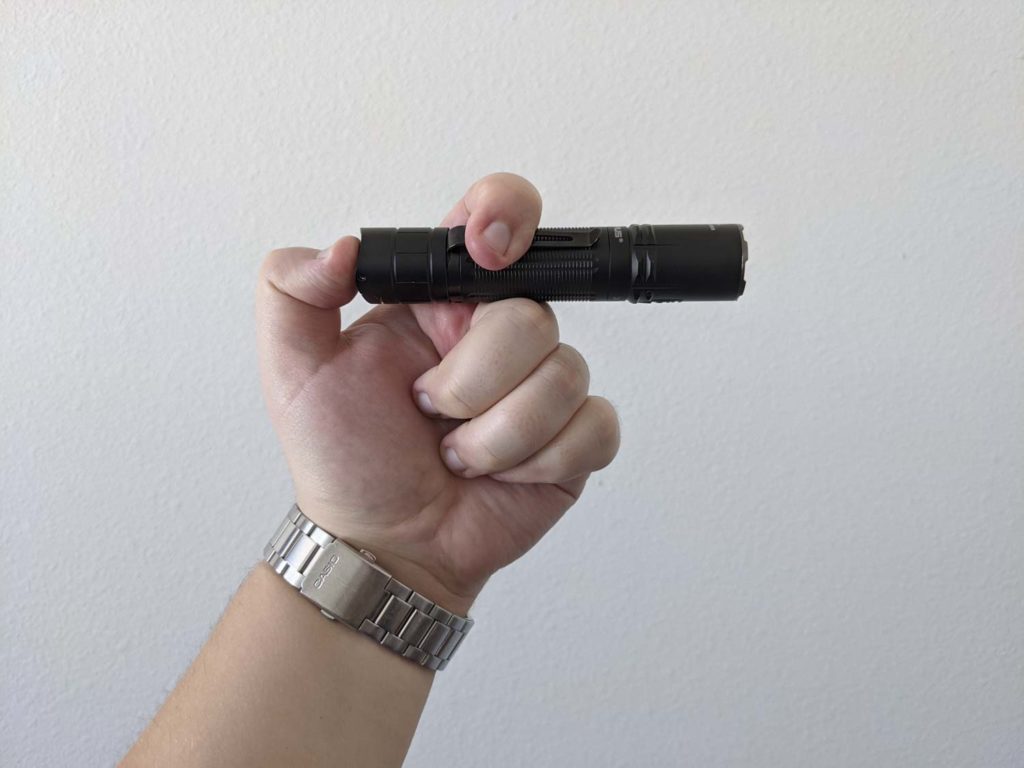
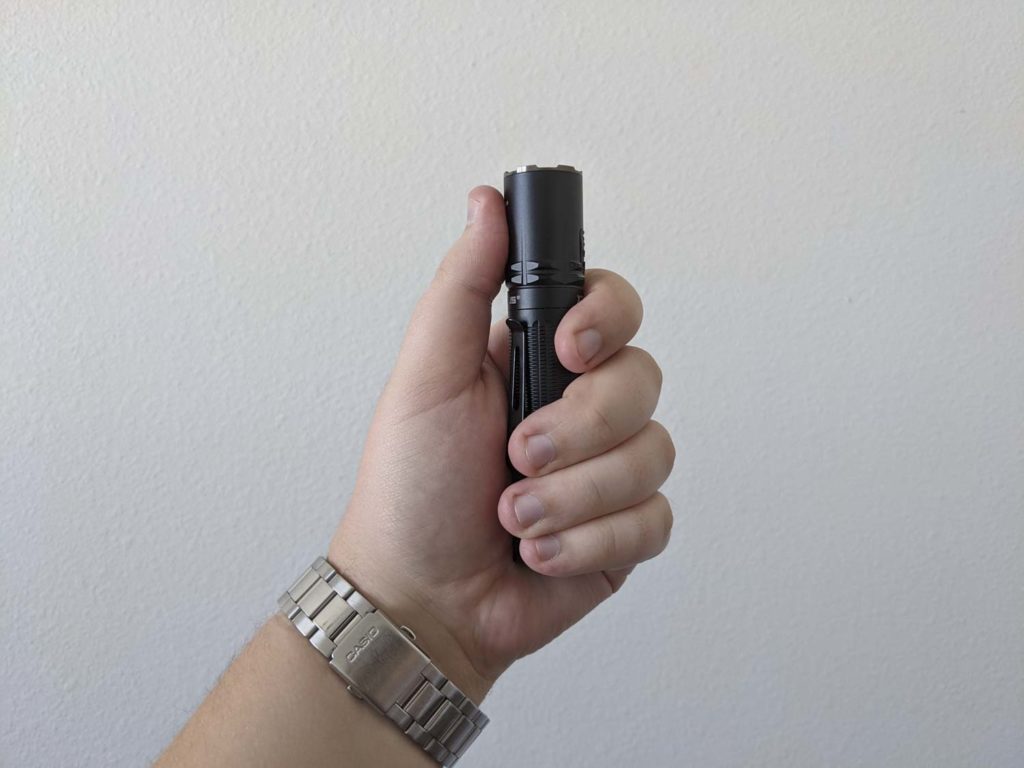
Build Quality, and Warranty
Visually, XT2CR Pro looks like a fairly typical black, aluminum, 1″ tube light. It’s got some texturing on the body for grip and some protrusions on the head to prevent rolling. Build quality is good. The anodizing feels smooth and even. The tailcap feels a little rough and gritty when unscrewing it, but the threads are anodized and appropriately lubricated. The only other part of the light I was able to remove is the bezel, everything else appears to be glued. Overall the light feels solid and dense in the hand, like a high quality piece of kit.
For warranty, Klarus (at their discretion) will repair or replace your light if it fails within 5 years of normal use from the proof of purchase date.

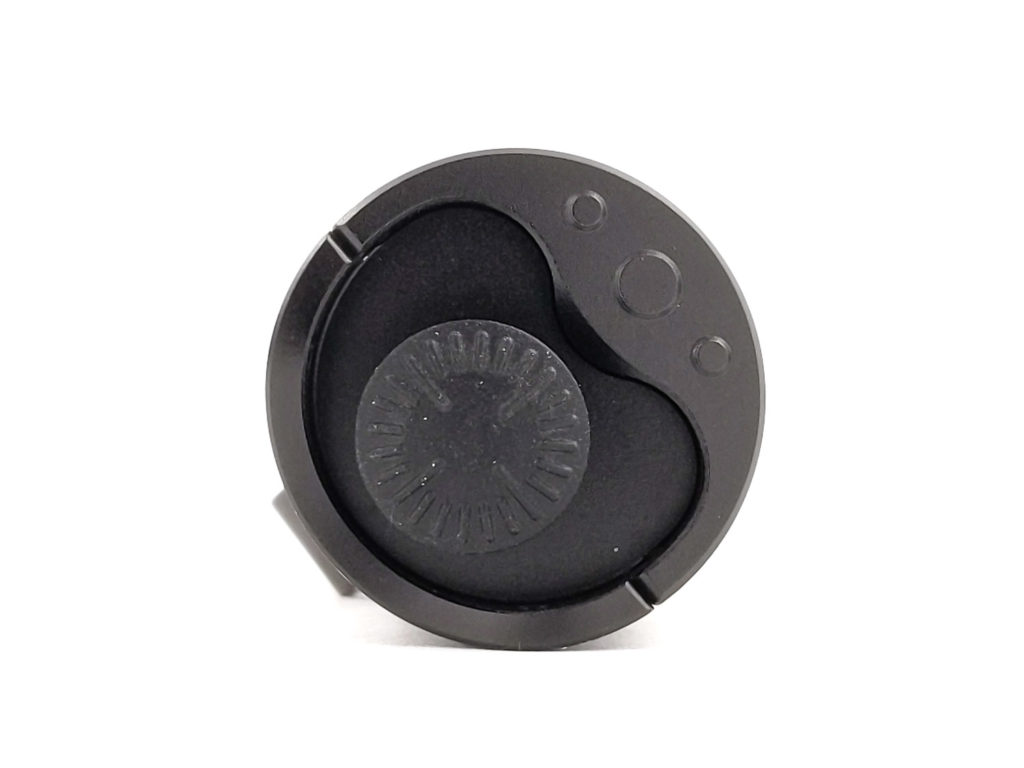
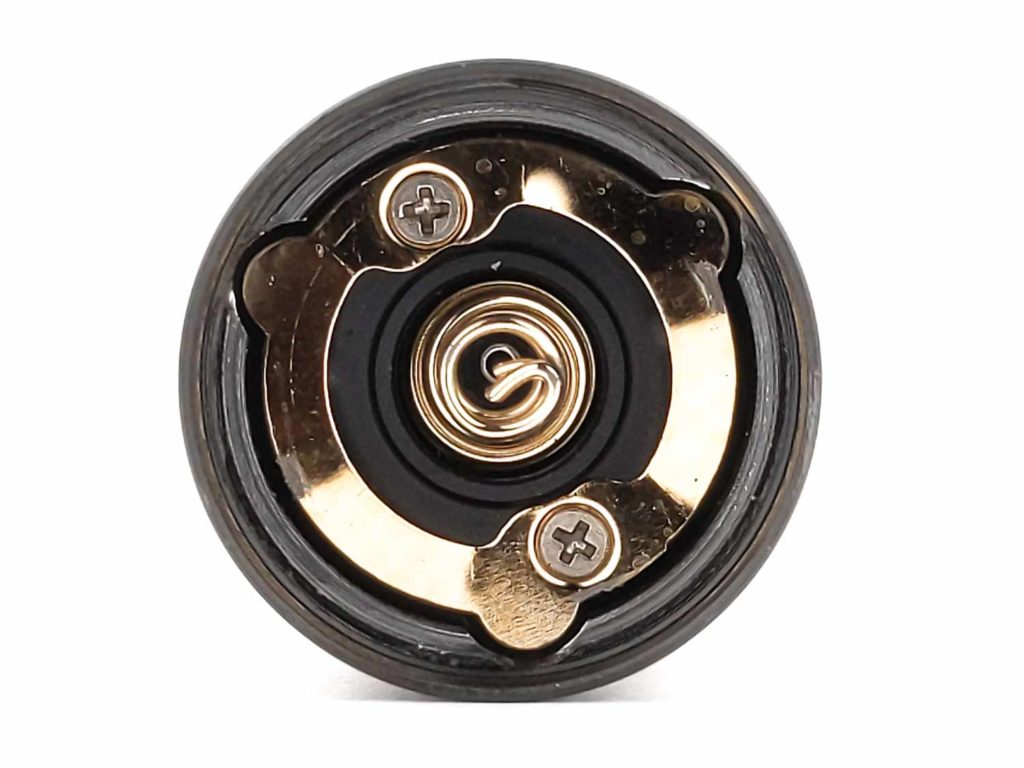
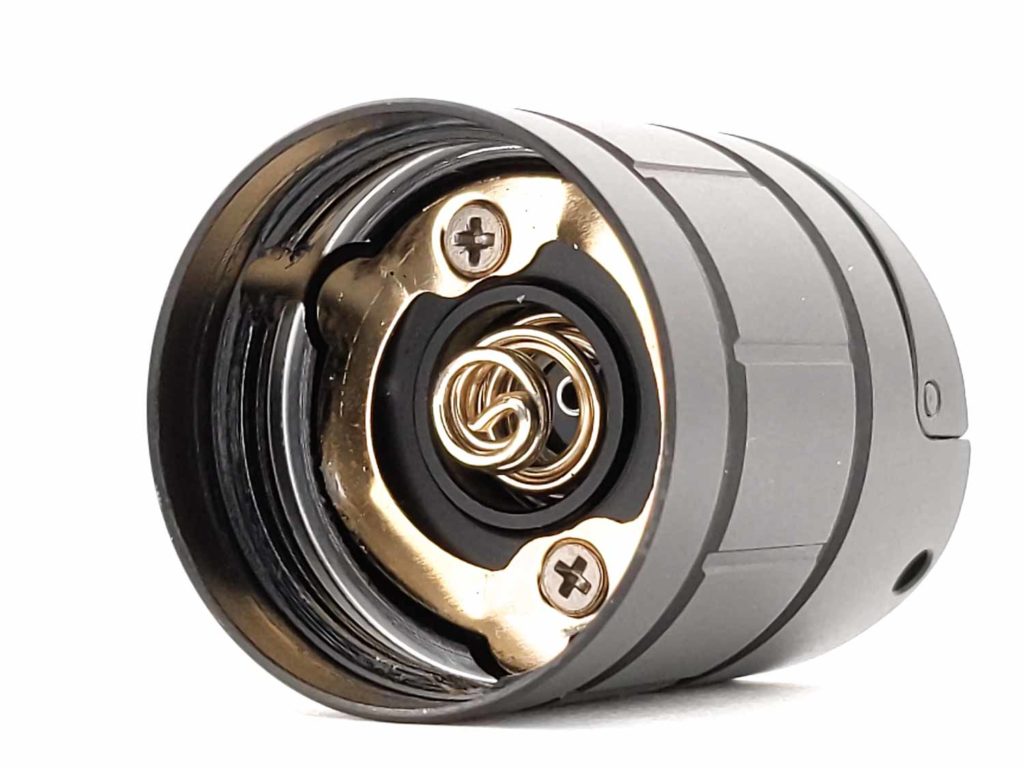
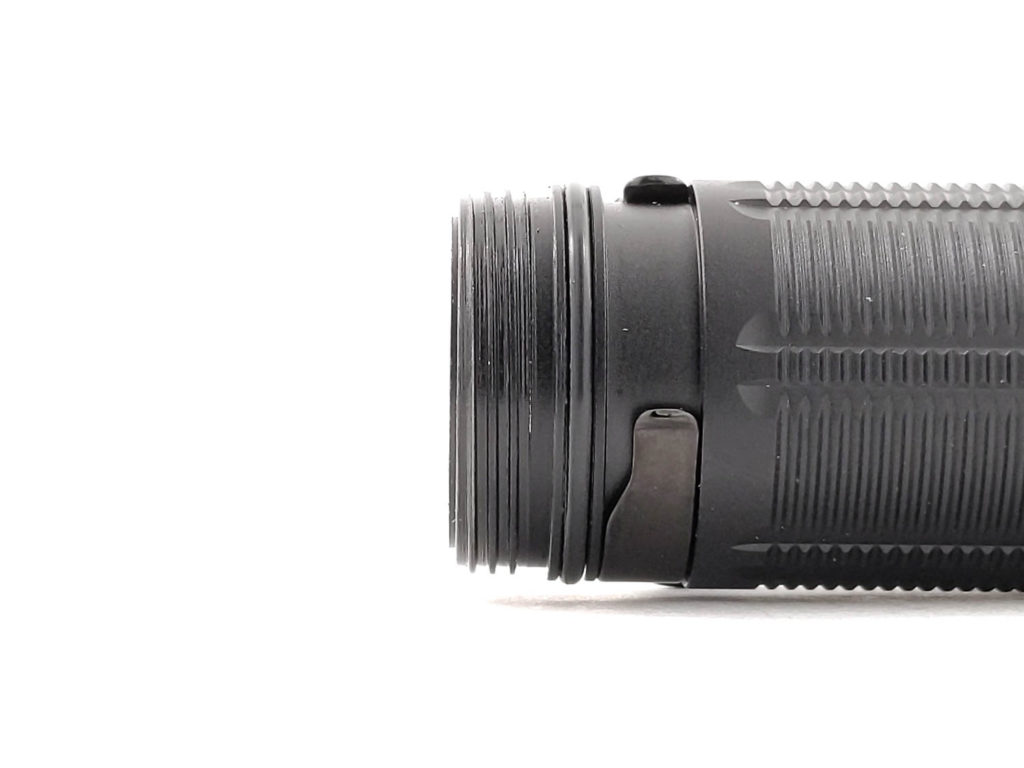
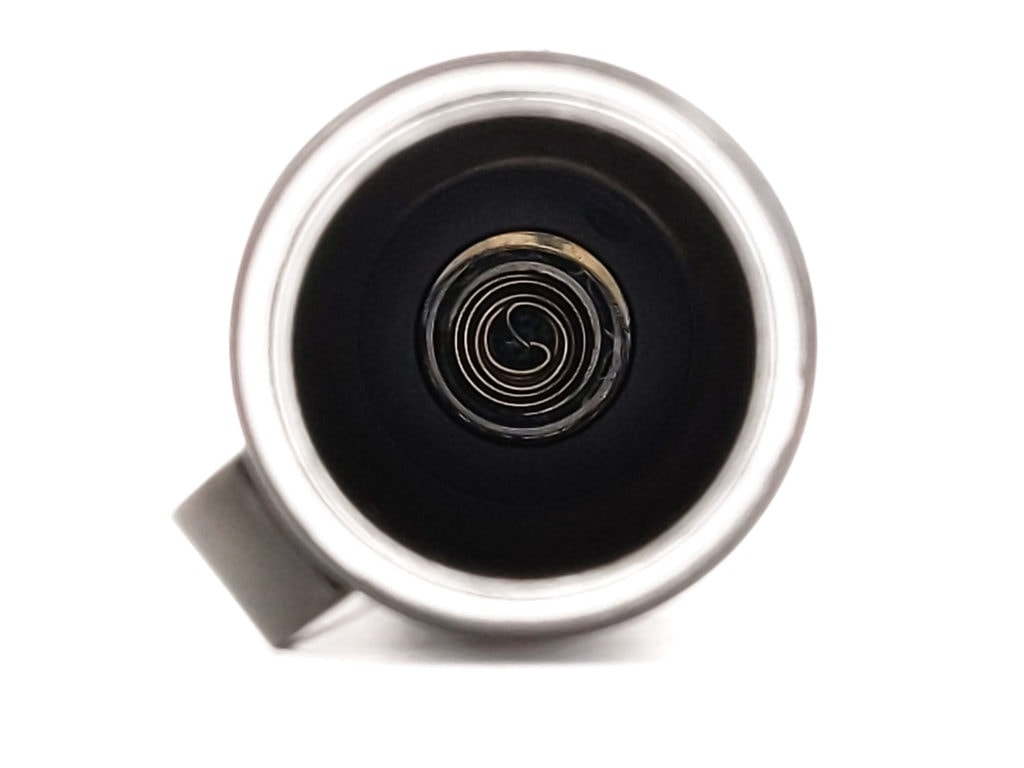
LED, Lens, Bezel, and Reflector
XT2CR Pro uses a Cree XHP35-HD emitter sitting in an orange peel reflector. Using an Opple Light Master 3, I measured minimum CCT at 5000K and maximum at 6500K. When the light is diffused in my photo booth, I get an average CCT of 5500K with a CRI of 70. This emitter produces a lot of tint-shift, the color temp isn’t very pretty, and thanks to the dome it’s pretty floody too. I would have preferred to see a smaller, domeless, warmer emitter here.
The bezel is a darkened stainless steel and it’s fairly sharp. I would expect this to tear through a pocket pretty quickly if you decided to carry this light. I was able to remove the bezel, but not the lens or reflector.
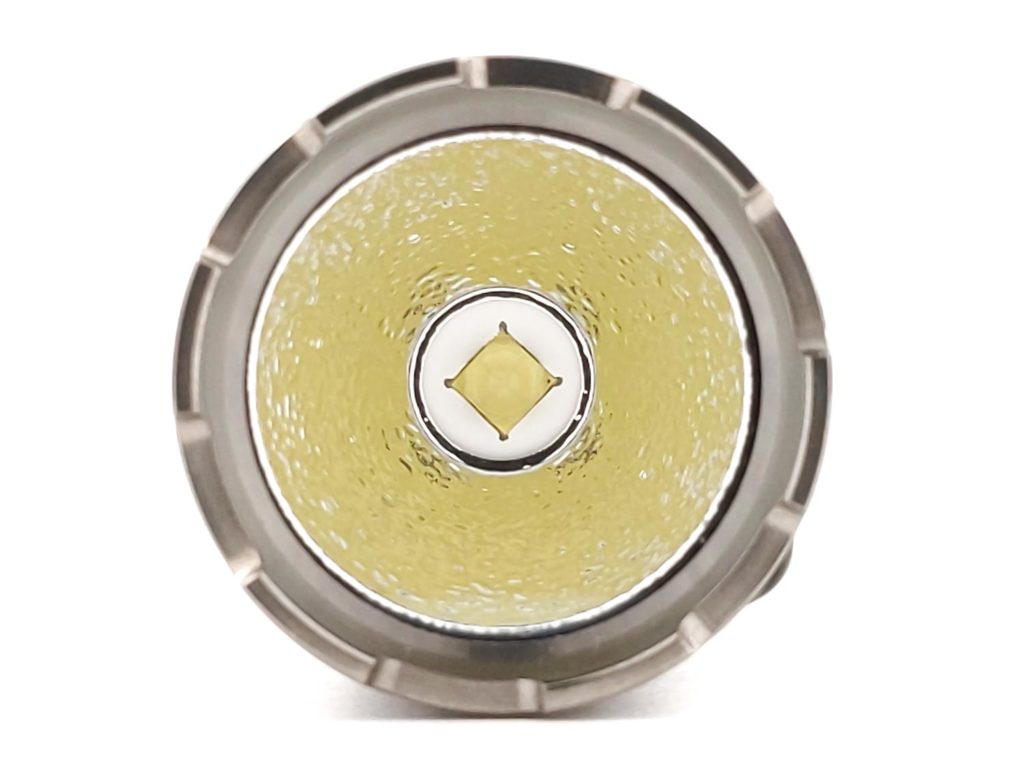
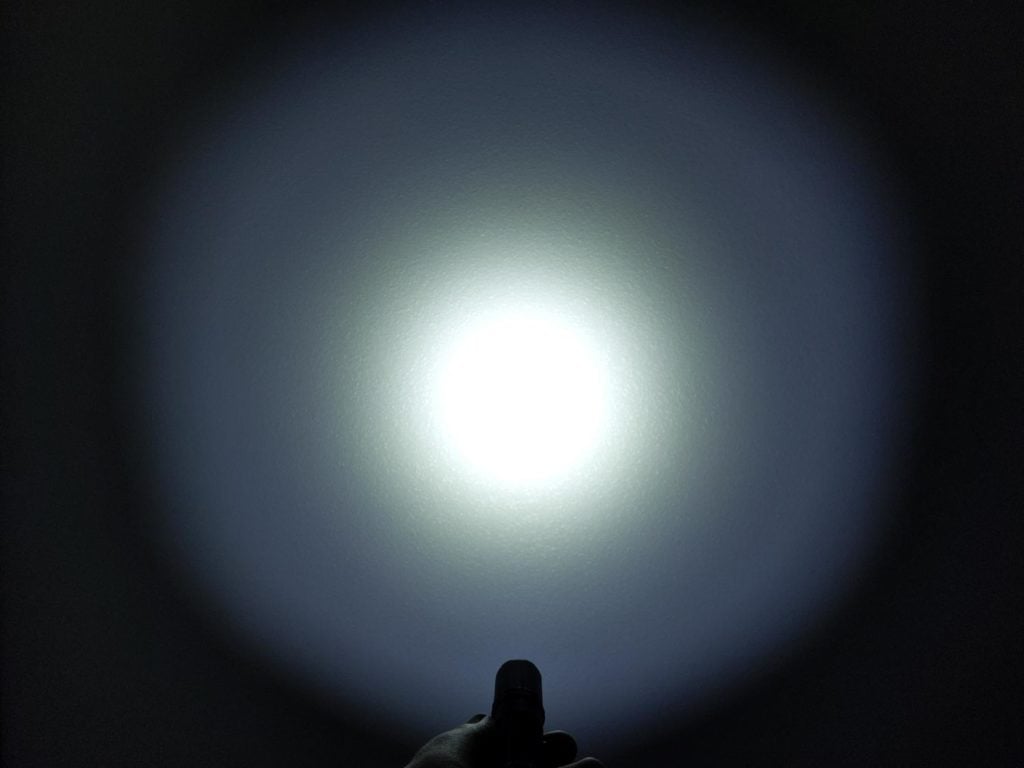
Dimensions and size comparison
- Length: 13cm / 5.12 inches
- Bezel diameter: 2.61cm / 1.03 inches
- Head diameter (maximum): 2.8 cm / 1.10 inches
- Body diameter: 2.54cm / 1.00 inches
Weight:
- Without cells: 92 grams / 3.25 oz.
- With cells: 139 grams / 4.9 oz.
Flashlight size comparison
From left to right: Convoy M1 with Thyrm Switchback clip, Convoy S12 with Noctigon KR1 clip, Klarus XT2CR Pro, Streamlight Protac Rail Mount HL-X, Wurkkos WK02
I think the main competitors to XT2CR Pro are Olight’s Warrior series, since they offer direct access to Turbo & Strobe from off like XT2CR Pro does. They also offer a moonlight mode that’s great for discrete lighting and won’t give away your position, which XT2CR Pro doesn’t have. But, they require Olight’s proprietary charging cable and batteries, whereas XT2CR Pro can use any USB A-to-C cable for charging, and any button top 18650 or two CR123A batteries.
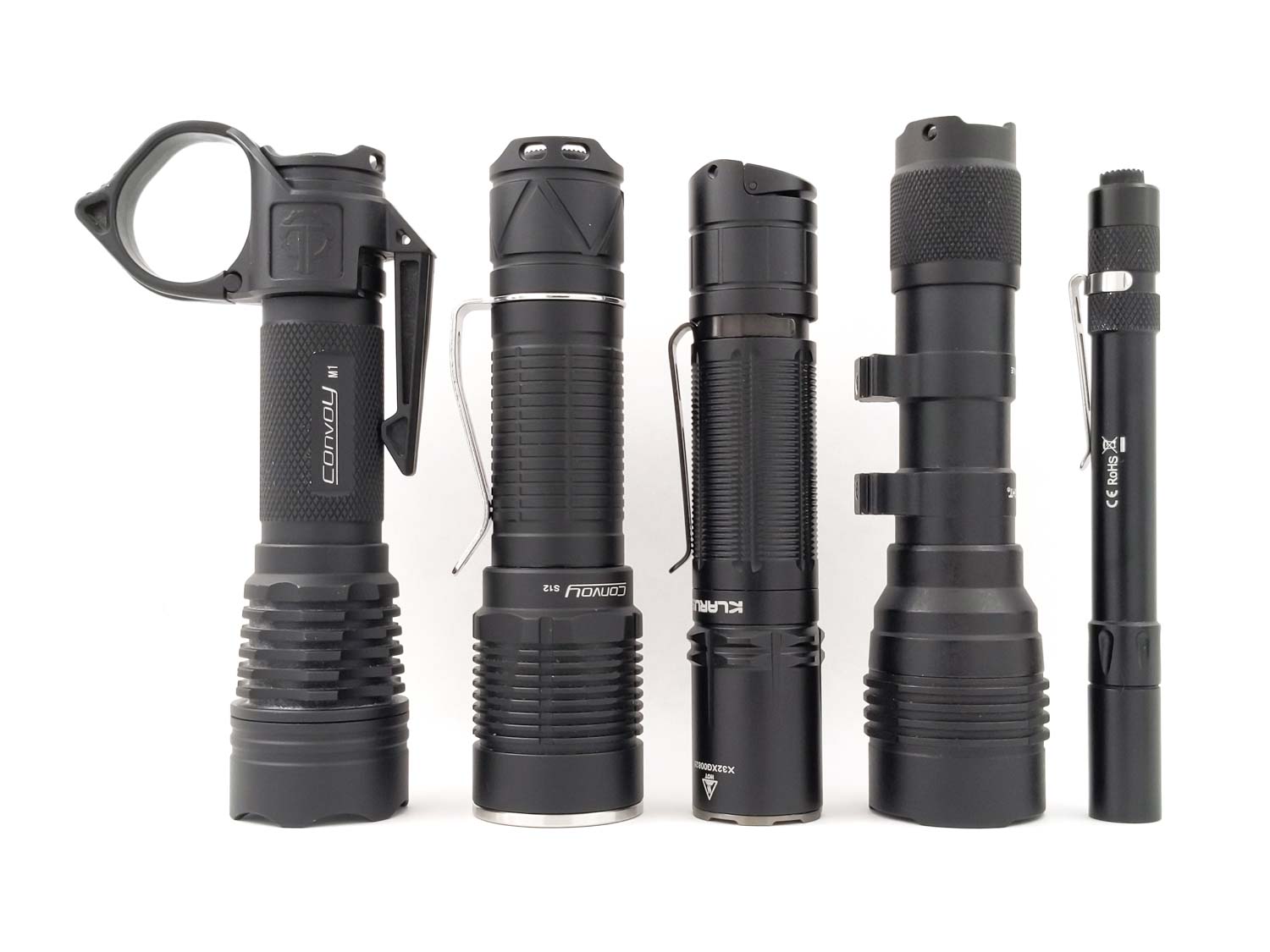
Driver & User Interface:
Available modes: Low, Medium, High, Turbo, Strobe, SOS
From OFF:
- Main switch always goes to Turbo
- Secondary switch goes to Strobe in the tactical mode group
- Secondary switch goes to low in the outdoor mode group
- A half-press of the main switch is momentary, a full press is constant on
- A <2 second press of the secondary switch is momentary, a >2 second press is constant on
From ON (via main switch):
- Clicking the main switch turns the light off
- Clicking the secondary switch cycles the mode down
- Holding the secondary switch in the tactical mode group activates strobe
- Holding the secondary switch in the outdoor mode group for 3 seconds activates SOS
From ON (via secondary switch in Outdoor group):
- Pressing the main switch activates Turbo
- Clicking the secondary switch cycles the mode up
- Holding the secondary switch for >2 seconds turns the light off
From ON (via secondary switch in Tactical group):
- Pressing the main switch activates Turbo
- Clicking the side switch turns the light off
To change mode group:
- Hold down the secondary switch
- Wait for the indicator LED to start flashing red and green
- Tap the main switch
- Half-press & release the secondary switch
Mode memory:
- There is no mode memory. It always starts on low, Turbo, or Strobe, depending on what switch and mode group you’re using.
Shortcuts (from off):
- To Low: press the secondary switch while in the outdoor mode group
- To Turbo: press the main switch
- To Strobe: press the secondary switch while in the tactical mode group
Low voltage warning:
- There is no low voltage warning.
Strobe/blinkies
- Strobe
Lock-out mode:
- There’s no electronic lockout function. The manual says to just unscrew the tailcap a half turn, which is mechanical lockout. Both switches take quite a bit of force to actuate, so I’m not concerned at all about accidental activation.
PWM
- Neither I nor my phone camera can see any PWM. I can’t hear any PWM whine from the driver in any mode either.
Additional info on the UI:
- The tactical mode group is nice for instant access to Turbo and Strobe. There’s no shortcuts to lower modes in this group though, so it’s not great for utility use. I wish there were a moonlight mode as well for discrete lighting without giving away your position.
- The outdoor mode group is pretty bad. Having to hold the secondary switch down for a full two seconds to turn the light on low is incredibly cumbersome. Having to hold it for a full two seconds to turn the light off is even more cumbersome. I found myself just using the tactical mode group because turning the light on with the main switch and then cycling down to low is faster than just going straight to low.
- Overall this UI is designed for tactical use, not utility.
Since XT2CR Pro uses a 12V emitter (XHP35-HD) and a single 3.6V battery, it must be using a boost driver. Boost drivers efficiently convert lower voltage from the battery up to the LED’s voltage. They typically offer fairly good regulation as well. I was unable to get a good photo of the driver, since the head and body tube appear to be glued together (boo).
Regulation is better than average. On Turbo, maximum achievable brightness decreases with battery voltage, which is common. High is better, but as the cell gets close to empty, brightness is limited. Medium and Low both perform well and can produce the same brightness until the battery is all but completely empty. This is about what I’d expect from a single cell driving a 12V emitter. Well done, Klarus.
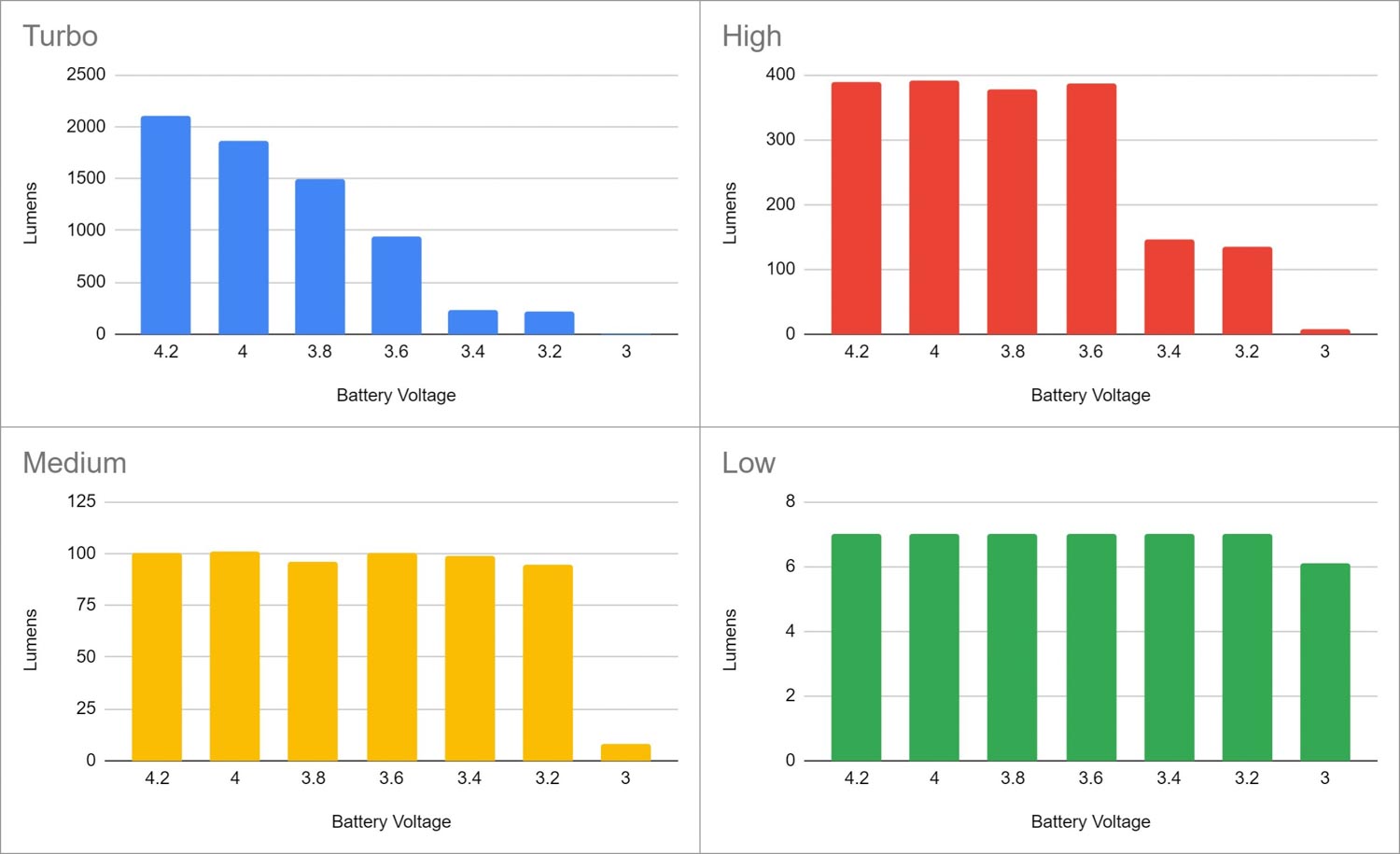
Batteries & Charging
XT2CR Pro comes included with a Klarus branded, protected, button top, 3100mah, 18650 cell. It’s a fine cell and I measured the capacity at 3184mah with my XTAR VC8 Plus. Notably, the product page mistakenly advertises a 3600mah cell in one spot. According to Klarus, it will also run on two CR123A’s. I wasn’t able to test that since I don’t have any CR123A’s on hand at the time of the review. I wouldn’t recommend using them unless you’re in an extremely cold environment or if you’re storing them for years and years at a time.
Klarus built a USB-C charging port right into the head of the light. It’s covered by a rubber flap that’s a little bit difficult to access deliberately, but also came open by accident once or twice during my testing. I wouldn’t take this light swimming. There’s a small indicator LED next to the port. When charging, it glows red. When charging is complete, it glows green. It also glows right after the light is turned on to indicate battery status. Only low and medium mode are accessible while charging, and you don’t have to click the switch to “on” for charging to work, like you do with some tailswitch lights. Charging terminates at 4.21V. Only A-to-C charging is supported, not C-to-C. That’s disappointing since the whole point of USB-C is to be universal. This means you probably can’t use the charger bundled with your phone or laptop to charge this light. During charging, especially if the cell is mostly drained, the light gets quite warm at the head. It’s not hot, nor concerning, but I haven’t noticed this in any other lights. The charging speed doesn’t strike me as being particularly fast at four and a half hours from dead to full.
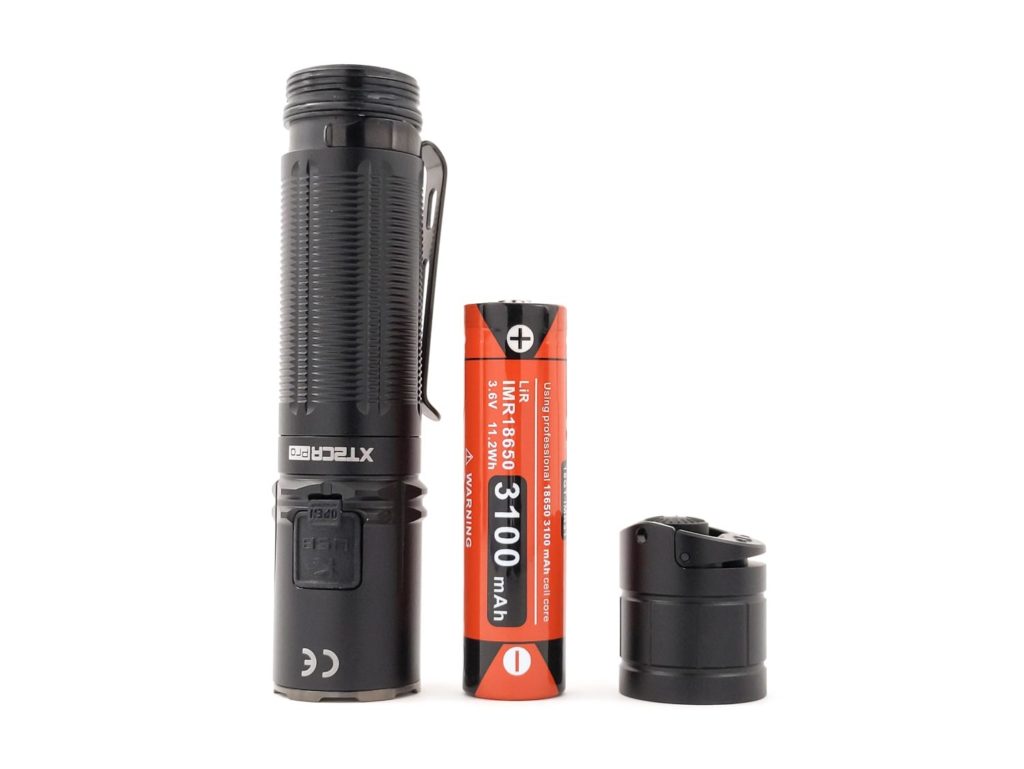
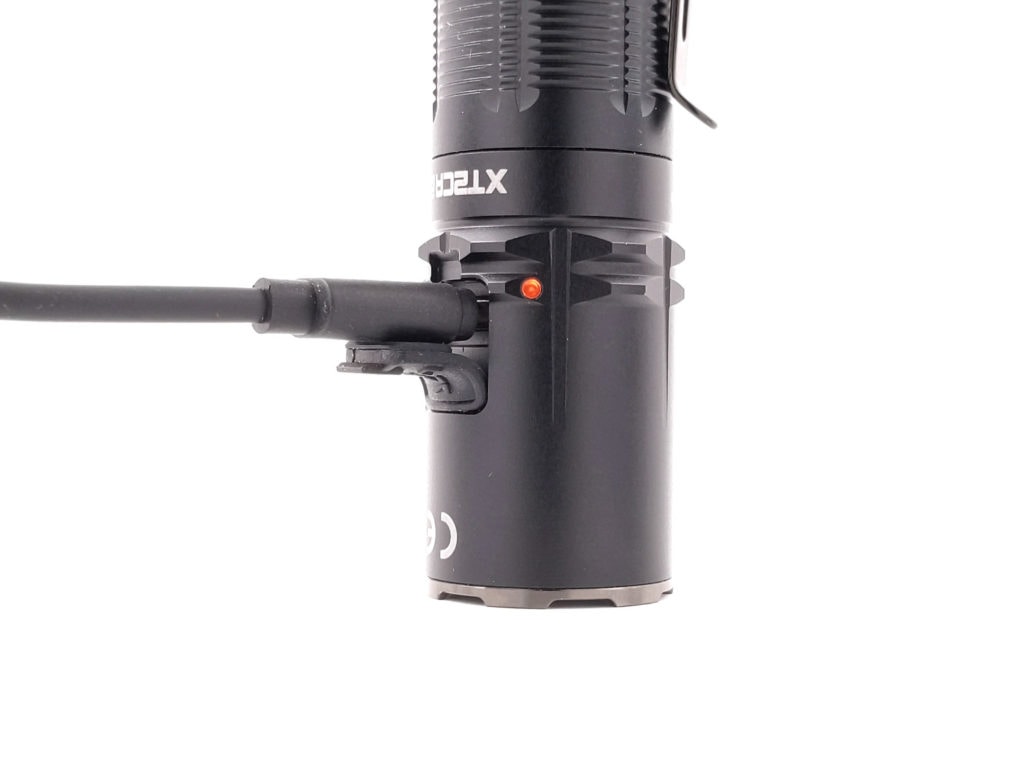
Performance
Lumen measurements:
Lumen measurements were taken on a “Texas Ace 3.5″ Lumen Tube”. Runtime tests were performed with the Ceilingbounce app on my smartphone. Tests were performed with a fully charged included battery.
| Mode | Specs | start | 30 sec | 10 min |
| Low | 10 | 7 | 7 | 7 |
| Med | 100 | 100 | 100 | 100 |
| High | 400 | 388 | 388 | 380 |
| Turbo | 2100~700 | 2100 | 1880 lm | 497 |
Parasitic drain: There is undoubtedly some parasitic drain because both switches are technically e-switches, but I was unable to take current measurements because of the dual-tube body design.
Runtime tests
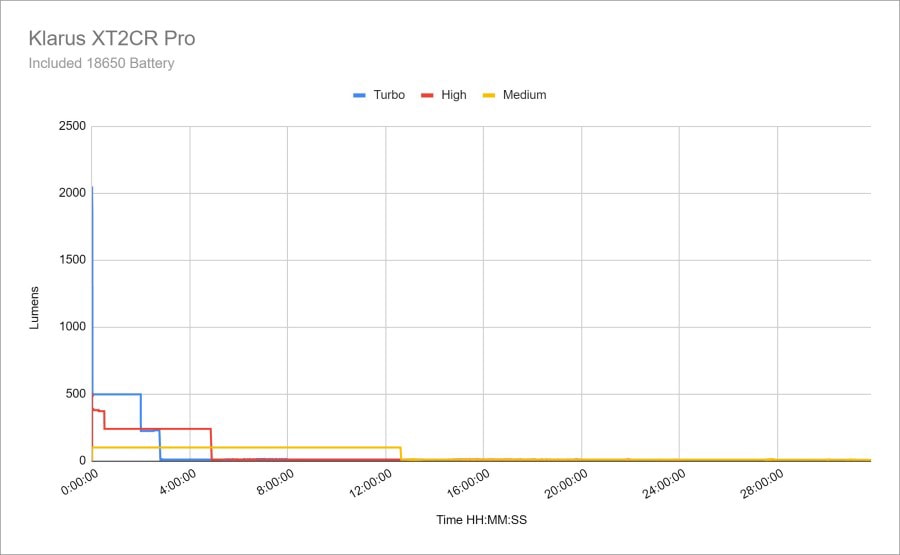
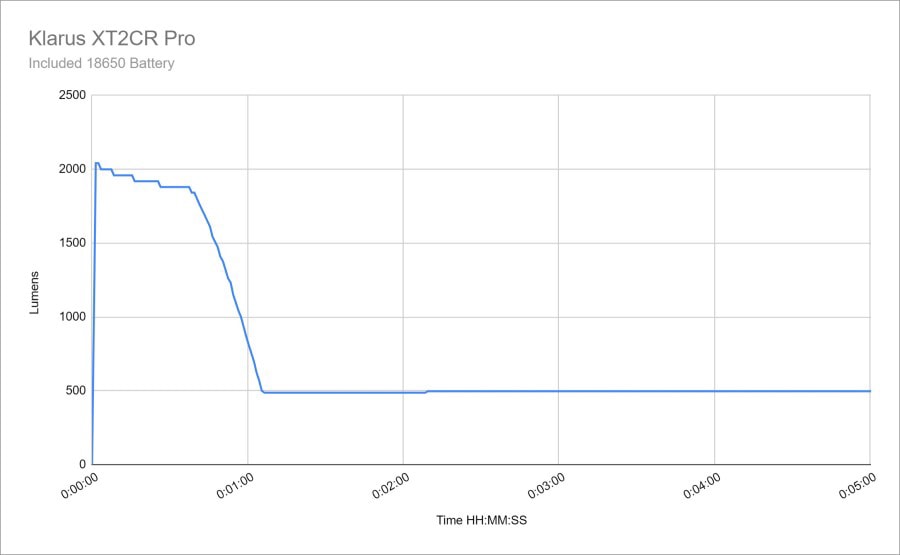
Turbo starts out at the quoted 2100 lumens but starts stepping down slowly and immediately. By 30 seconds it’s dropped down to 1880 lumens, and it starts dropping quickly before the 45 second mark. It settles right at 500 lumens just after the 1 minute mark and it stays there for exactly two hours. At that point, it drops to 225 lumens for about 45 minutes. Finally, it drops to about 10 lumens. I let it run on the 10 lumens setting for over 10 hours before stopping the test to make sure it didn’t over-discharge the battery. When I stopped the test, I measured the cell voltage at 3.37V. If it’s still measuring 3.37V ten hours after stepping down, it steps down way too early.
High starts at 338 lumens and stays pretty close to that for half an hour. Then, it drops to 240 lumens for just under four and a half hours. The light didn’t get hot at 338 lumens so I don’t understand why it drops to 240 lumens instead of just staying flat at 338. Next there’s a large step down from 240 to 10 lumens and it stays at 10 lumens until the 24 hour mark where it shuts off.
Medium is a perfectly flat 100 lumens for about twelve and a half hours. Then it steps down to about 10 lumens for 19 more hours and finally shuts off.
LVP: In my high and medium tests, I let the light shut off on its own. The battery still had voltage, so the light itself has low voltage protection built in and it isn’t relying on the battery’s protection circuit. I observed low voltage protection shut off the light just below 2.7 volts.
Throw numbers:
CD measurements were taken with a Digital Illuminance HS1010A (the meter included with the Texas Ace Lumen Tube).
| Mode | Specs | Candela measured | Meters | Yards |
|---|---|---|---|---|
| Low | Not specified | 44 cd | 13 | 15 |
| Medium | Not specified | 628 cd | 50 | 55 |
| High | Not specified | 2,435 cd | 99 | 108 |
| Turbo | 14,400 cd | 11,800 cd | 217 | 238 |
Beamshots
The beam is… usable. There’s a lot of tint-shift and the spill is hexagonal. It allows you to see things, but it doesn’t look very pretty. The hotspot is wider than I would expect from a tactical light. While not great, this beam will do the job in most situations.
Comparing with Streamlight HL-X and Convoy M1 really shows how much more intensity a larger head adds, even with a similar sized emitter in HL-X. As you can see from the beamshots, their beams are significantly narrower and are noticeably more intense downrange compared to XT2CR Pro. They’ll also have a more sustainable throw because of their lower lumen output and higher candela. These are the sort of beam I would expect from a tactical light, not the wide, colorful mess that XT2CR Pro produces.
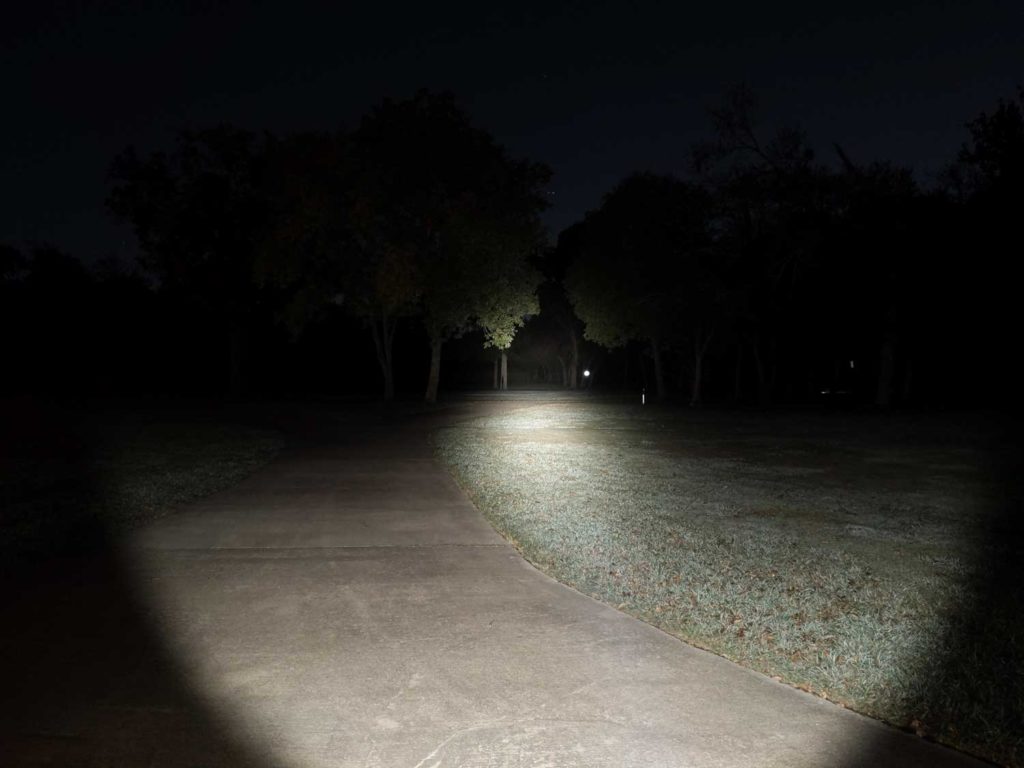
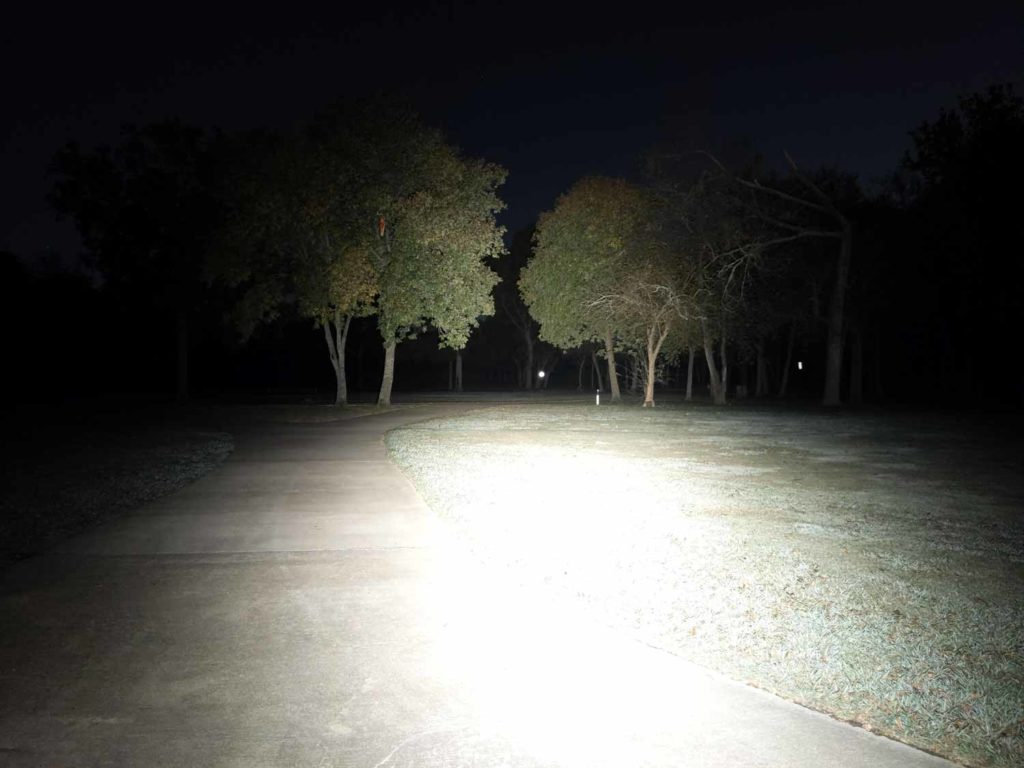
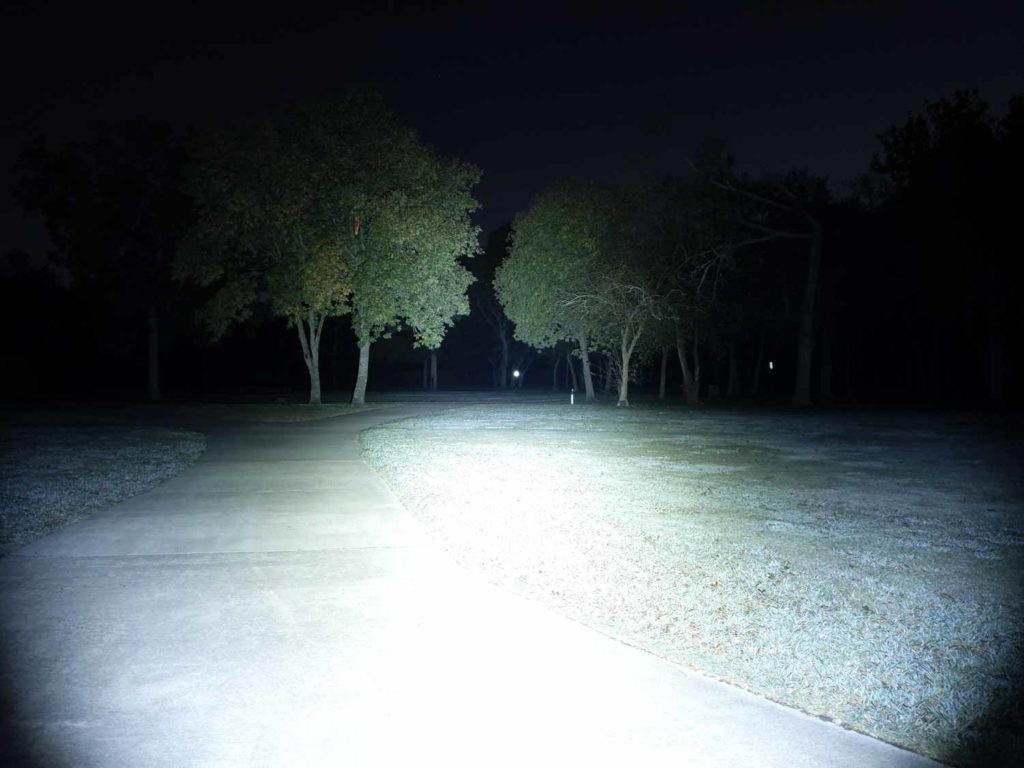
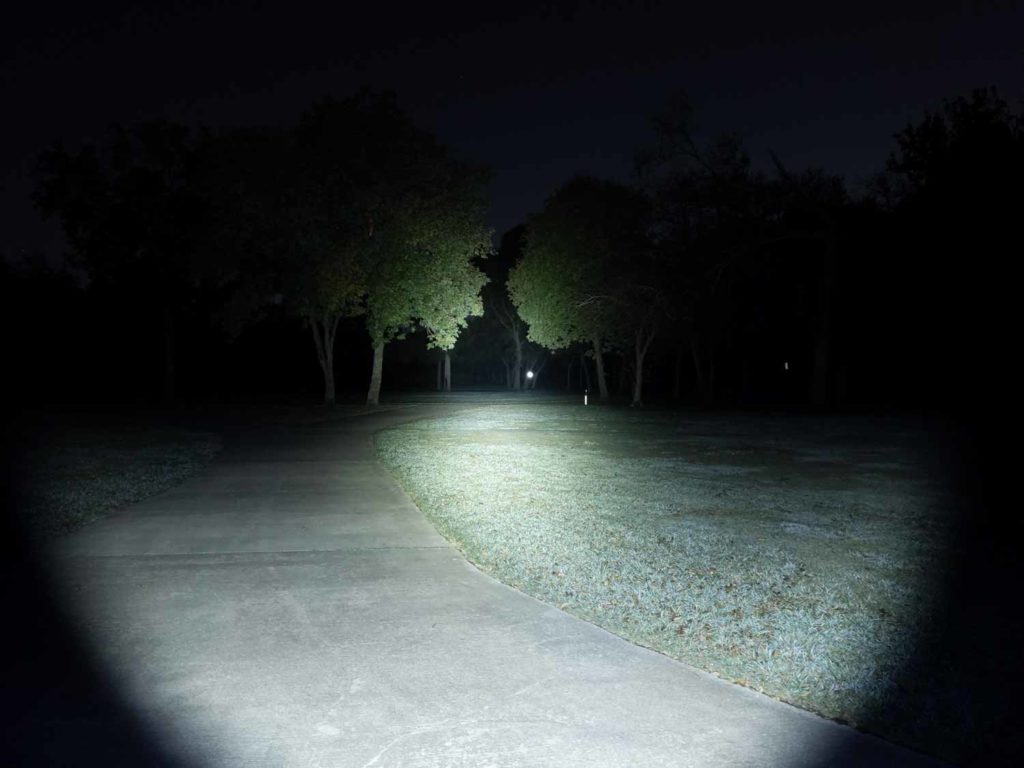
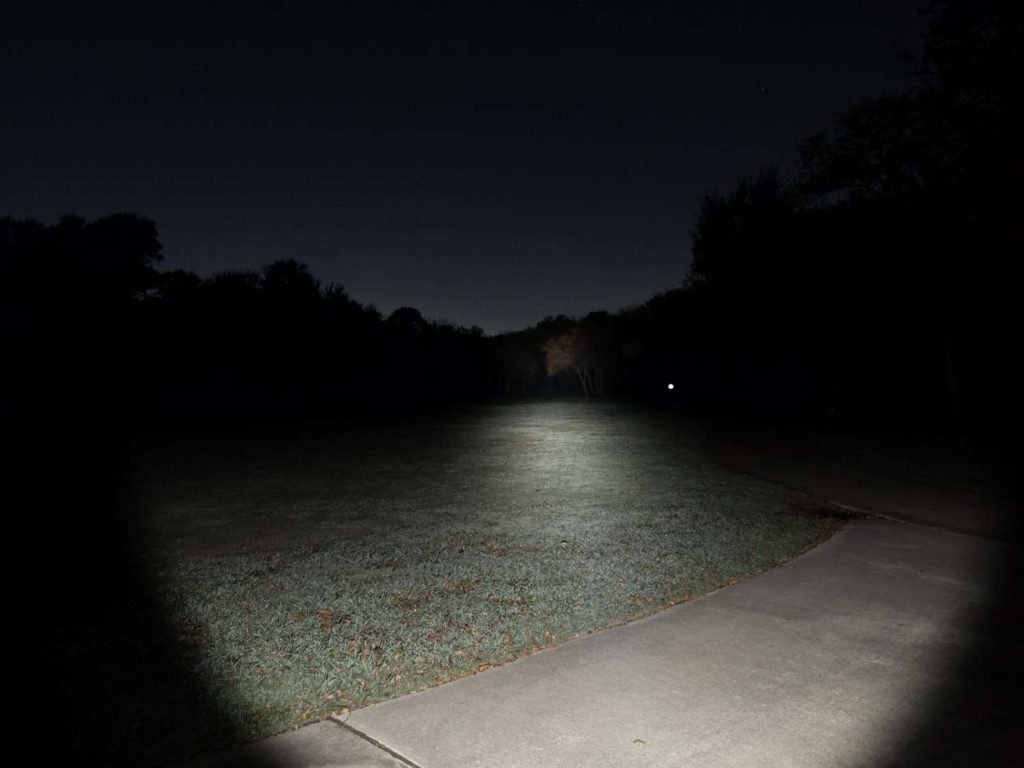
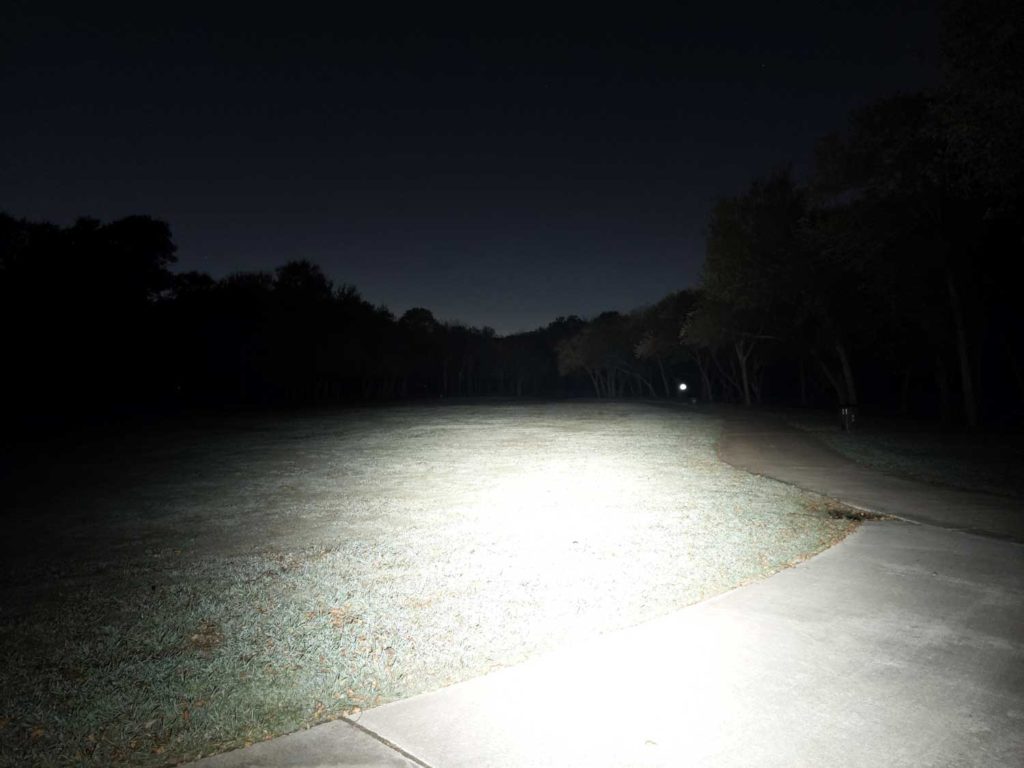
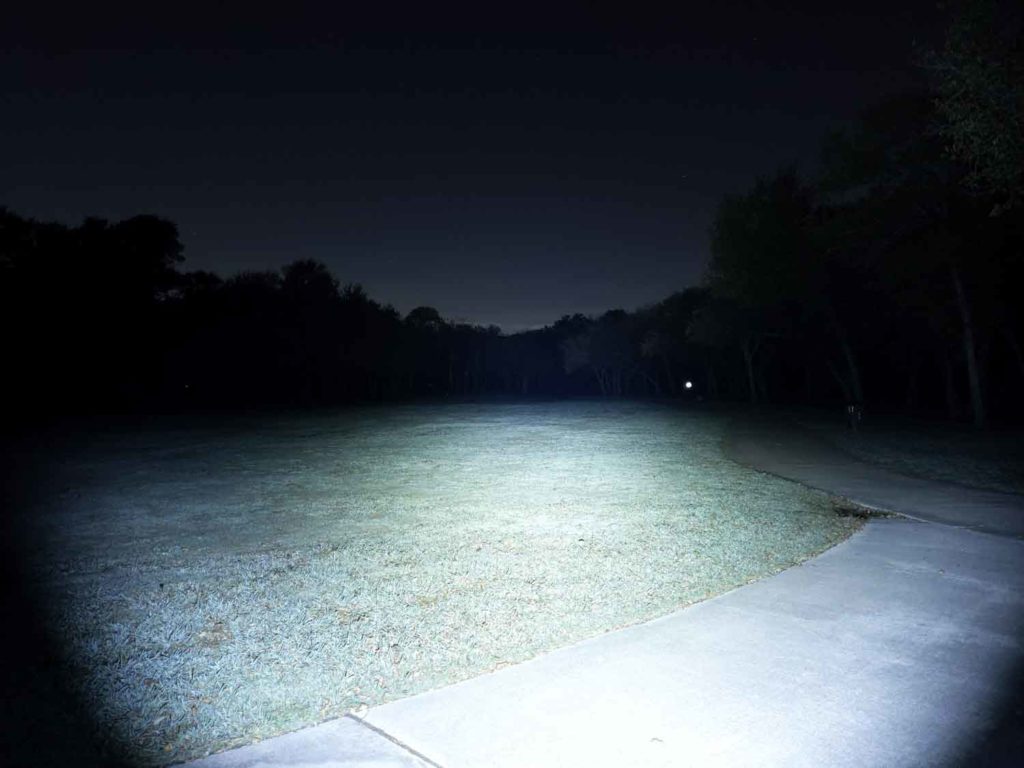
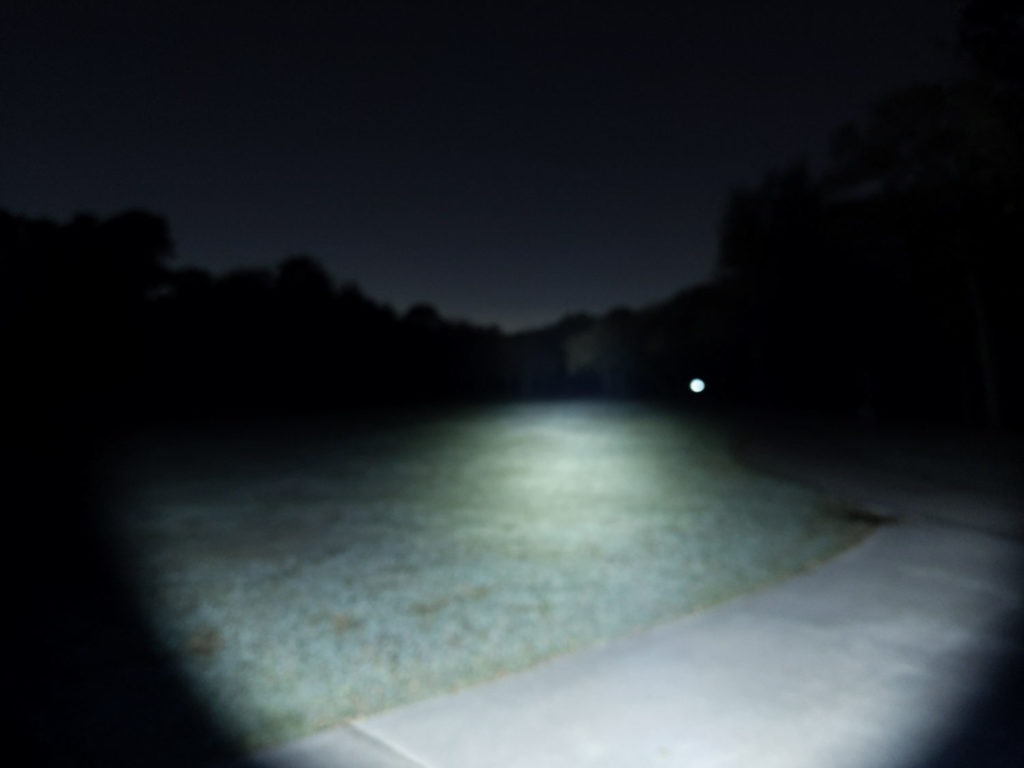
Disclaimer: This flashlight was sent to me for review at no cost by Klarus. I have not been paid to review, nor have I been holding back on problems or defects.
Final Verdict
Pros
- Provides instant access to Turbo, and Strobe
- Battery included
- Relatively bright for its size
- Well regulated driver
- Great build quality
Cons
- The UI is cumbersome for non-tactical use
- Less-than-pretty beam
- Clip and bezel will devour pockets
- No C-to-C charging support
- No moonlight mode
Explanation on star ratings:
1: Avoid: my phone flashlight would be a better choice – 2: Poor: significant defect or issues, much better options available at the same price – 3: Average: some defects or issues – 4: Good: recommended (minor issues) – 5: Great: highly recommended
Author: Angus
3 stars: ★★★
When I got XT2CR Pro, I thought it would be a great EDC light with some tactical features. It turned out to be a poor choice for EDC because of the strong clip, aggressive bezel, ugly beam, and UI. But, most of those things contribute to it being a good, compact tactical light.
Instant access to Turbo and Strobe from off is pretty compelling, as few other lights offer that feature. The build quality, driver, and switches are excellent. The inclusion of a standard charging port & a standard battery help it stand out from the competition as well. The only thing I find missing is a moonlight mode for discrete illumination that won’t give away your position.
If you’re looking for instant Turbo & Strobe, with non-proprietary battery & charging, in a compact package, this is a good option. I give it three out of five stars.
Klarus XT2CR Pro For Sale
1lumen selects and reviews products personally. We may earn affiliate commissions through our links, which help support our testing.